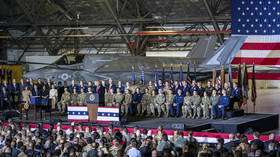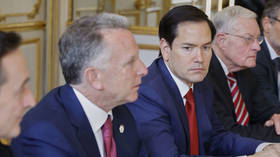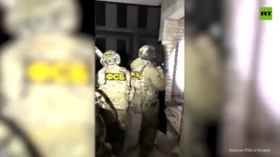‘Russian aggression’ is just a pretext for US politicians to further bloat 2020 defense budget, while Moscow won’t even care

By including provisions to stop Russian pipelines and target Russia’s actions in Syria, the new US defense budget demonstrates Washington’s overreach, but likely does nothing to rein in Vladimir Putin.
$718 billion for NDAA 2020 includes ‘lethal aid’ for Kiev
Last Friday, President Donald Trump signed the National Defense Authorization Act (NDAA) for 2020. The NDAA lays out the annual budget and expenditures of the Department of Defense and allows Congress to set the policies under which the money appropriated can be spent. The modern American military budget, which for 2020 is slated to be a whopping $718 billion, underwrites the world’s largest military and defense enterprise. The NDAA for 2020 builds on the notion that the US is engaged in a major power confrontation with Russia and, as such, it mandates that the Pentagon devise and implement strategies designed to impose political, military, economic, budgetary, and technology costs on Russia.
Also on rt.com Just think of the US’ Endless Wars as a constant string of increasingly derivative Hollywood sequelsThe NDAA aims to accomplish this by seeking to deter what it calls “Russian aggression” through, among other measures, authorizing some $300 million in security assistance to Ukraine, inclusive of money for “lethal defensive items” and new authorities for coastal defense cruise missiles and anti-ship missiles. The NDAA also prohibits military-to-military cooperation with Russia. While US-Russian relations will continue to be held hostage to the vagaries of American domestic politics –manifested in legislation such as the NDAA for 2020– for the foreseeable future, the congressional budgetary actions targeting Russia are but a tempest in a tea pot, easily sidestepped by more sober minds.
The NDAA is a policy document, and does not provide actual budget authority, which is the sole purview of subsequent appropriations legislation. Since 1961, the NDAA has served as the forum for the US Congress to shape defense policy. Moreover, the amount of money involved in the defense budget has provided Congress with an opportunity to use the defense budget process to expand its intrusion into the economic, political and spiritual aspects of American life, and intrude on foreign policy matters –including US-Russian policy– by attaching so-called “rider bills” onto the NDAA.
What does Nord Stream 2 have to do with anything?
For example, the NDAA for 2020 contains the “Caesar Syrian Civilian Protection Act,” which targets the government and armed forces of Russia by imposing sanctions that punish Russia for alleged war crimes committed by targeting civilian populations, and restricts Russian efforts at reconstruction inside Syria. A second rider, the “Protecting Europe’s Energy Security Act,” calls for the president to impose stringent sanctions on companies and individuals that provide assistance in the construction of two major Russian gas pipeline projects, Nord Stream 2 and Turk Stream. The co-sponsors of this legislation, Senators Ted Cruz and Jeanne Shaheen, view these pipelines as representing a grave threat to the national security of the United States and its European allies, contending that the act counters Russian “expansionism” and “economic blackmail.”
Also on rt.com US & Russia won't go to war over SyriaFor all its anti-Russian posturing, however, the NDAA for 2020 will likely have little actual impact on Russian activities, malign or otherwise. Russia has shown itself impervious to the anti-Russian posturing of the US in recent years and, if anything, the US actions have only entrenched Russia further, resulting in countermeasures –for instance, in the field of missile defense and missile technology– that nullify any advantage the US might have sought to begin with. The rider bills on the NDAA are mainly for domestic political consumption, having little meaningful impact on foreign policy. In Syria, Russia continues to aid the Syrian government, undeterred (or, more accurately, unconcerned) about any threatened sanctions. The same holds true regarding the threats against the Russian gas pipeline projects. Turk Stream is too far advanced to be impacted at all, and Russia had anticipated possible US sanctions targeting Nord Stream 2 and will introduce measures that will enable the project, which is near its end, to be completed regardless. Moreover, Russia’s principal Nord Stream 2 partner, Germany, has taken umbrage at any and all efforts by the US to halt that project, further straining relations between the two NATO allies.
Realpolitik over posturing
Additional evidence of the relative impotence of the anti-Russian posturing undertaken by the NDAA for 2020 could be seen in mid-December of this year, when General Mark Milley, the Chairman of the US Joint Chiefs of Staff, met in Geneva, Switzerland, with his Russian counterpart, General Valery Gerasimov, to discuss issues pertaining to the operational and strategic deconfliction of their respective forces inside Syria. These talks, which are designed to avoid miscalculation and to promote transparency, represent a reality that no politically motivated legislation can undo.
In the end, the reality of the US-Russian relationship is governed by geopolitically driven realpolitik, and less by the vagaries of domestic American political whimsy. While the Cold War helped feed a policy narrative which at the time allowed for the integration of domestic and foreign policy over a sustained period, the perceived threats that existed then are not present today – for example, there is no Russian Army poised to occupy Western Europe. The crisis in Ukraine is a localized conflict with little or no real potential to spread beyond its limited geographic confines, and the Syria intervention is likewise a scenario-driven event, more exception that rule when it comes to Russian power projection. The US Congress will continue to posture through legislation, but the real impact comes about when those words are transformed into action, or otherwise. The NDAA for 2020 makes a show at anti-Russian animus that does not necessarily manifest itself in actual policy implementation. Or, to put it another way, the Congressional legislation is all bark, and no bite.
Subscribe to RT newsletter to get stories the mainstream media won’t tell you.
The statements, views and opinions expressed in this column are solely those of the author and do not necessarily represent those of RT.
















